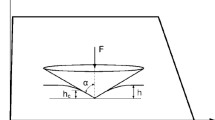Abstract
The use of vibratory techniques in the shaping of complex-shaped components, specifically, high-voltage insulators, by quasi-isostatic pressing are discussed. The advantage of quasi-isostatic pressing over hydrostatic pressing is emphasized.
Similar content being viewed by others
References
M. I. Timokhova, Factors Involved in the Hydrostatic Pressing of Electroceramic Components, Author’s Abstract of Candidate’s Thesis [in Russian], Moscow (1964).
R. Ya. Popil’skii and Yu. E. Pivinskii, The Pressing of Powdered Ceramic Mixtures [in Russian], Metallurgiya, Moscow (1983).
M. I. Timokhova, “Quasi-isostatic pressing of components from powder materials,” Novye Ogneupory, No. 11, 31–34 (2003).
M. I. Timokhova, “Quasi-isostatic pressing — a promising technology in the production of refractory components,” Novye Ogneupory, No. 6, 19–23 (2004).
M. I. Timokhova, “Volumetric quasi-isostatic pressing of powder materials,” Novye Ogneupory, No. 12, 43–44 (2004).
Author information
Authors and Affiliations
Additional information
__________
Translated from Novye Ogneupory, No. 6, pp. 13–16, June, 2006.
Rights and permissions
About this article
Cite this article
Timokhova, M.I. Vibratory techniques in isostatic pressing technology. Refract Ind Ceram 47, 152–154 (2006). https://doi.org/10.1007/s11148-006-0076-z
Received:
Issue Date:
DOI: https://doi.org/10.1007/s11148-006-0076-z




